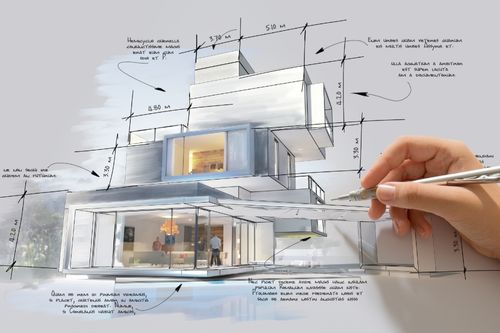Understanding the Collaborative Refine Between Architects and Engineers in Modern Construction Projects
The joint procedure in between engineers and designers is crucial in modern-day construction jobs, as it integrates layout intent with design feasibility. Discovering these dynamics exposes insights that can substantially affect task results and general sector standards.
The Relevance of Cooperation
The collective harmony in between architects and engineers is vital for the effective awareness of any kind of construction job. This collaboration combines distinct expertise and viewpoints, allowing the assimilation of innovative style with useful design options. By working with each other, architects and engineers can make certain that a task not only meets visual and practical demands however likewise sticks to safety and security, sustainability, and budgetary constraints.
Partnership promotes a shared vision, helping with the placement of goals and assumptions from the beginning. This alignment is important in attending to potential difficulties and mitigating dangers that could occur throughout the task lifecycle. A collaborative technique allows for the effective allowance of sources, maximizing both time and price.
The importance of cooperation includes the iterative procedure of layout and construction, where responses from engineers can notify architectural decisions, causing even more practical and lasting designs. Conversely, designers can influence engineers to assume artistically regarding exactly how to attain structural honesty without jeopardizing artistic intent. Ultimately, the collective connection between engineers and engineers is not merely advantageous; it is basic to the creation of top quality, useful, and ingenious developed environments that fulfill the needs of society.
Communication Methods and Devices
Reliable communication methods and tools are important for promoting partnership in between designers and designers throughout the project lifecycle. Developing clear networks of communication is important to make sure that all team members are lined up with task objectives, timelines, and duties. Regular conferences, both in-person and virtual, give chances for stakeholders to review progress, address concerns, and make informed decisions.
Using project administration software application, such as BIM (Building Info Modeling) systems, boosts collaboration by enabling real-time sharing of layout adjustments and technical specs. These tools assist in transparency, enabling engineers and designers to imagine changes and examine their effect on the general task.

Shared Objectives and Task Vision

Developing common goals includes open dialogue and a thorough understanding of each self-control's contributions. Engineers normally focus on layout intent, spatial connections, and user experience, while designers emphasize structural integrity, systems capability, and compliance with guidelines (cda architects). When these viewpoints are straightened, the result is a cohesive job that abides by both creative desires and technological expediency
Moreover, a distinct task vision fosters accountability see here among employee, encouraging each participant to take possession of their duty in achieving the preferred result. Regular check-ins and joint workshops can even more reinforce this commitment, permitting modifications to be made as the project evolves. Eventually, a shared vision not just improves team effort but likewise elevates the high quality of the final deliverable, bring about effective project conclusion.
The Duty of Modern Technology
Leveraging innovation has ended up being important in enhancing collaboration between architects and engineers. The assimilation of advanced software application tools assists in real-time interaction and details sharing, making it possible for teams to work much more effectively and properly. Structure Information Modeling (BIM) stands apart as a critical modern technology, allowing both engineers and engineers to develop in-depth 3D models that envelop design intent and structural stability. This common graph reduces misunderstandings and enhances the decision-making procedure.
In addition, cloud-based platforms make it possible for seamless cooperation, allowing task stakeholders to access and upgrade task information from anywhere. This fosters a culture of openness and liability, as changes can be tracked and reviewed in real-time. Furthermore, mobile applications further boost interaction, giving on-site groups with immediate accessibility to project specs and updates.
Emerging innovations such as man-made intelligence and artificial intelligence are additionally beginning to contribute in predictive analysis, aiding teams identify potential concerns prior to they develop. Eventually, the function of innovation in architecture-engineering cooperation not only enhances process effectiveness but additionally enhances development, resulting in more effective project outcomes. By accepting these technological improvements, architects and designers can ensure a more natural and effective collective procedure throughout the building and construction lifecycle.
Study in Successful Partnerships
Many case researches highlight the profound impact of efficient collaborations in between designers and designers on job end results. One significant example is the cooperation on the High Line in New York City, where landscape architects, engineers, read the full info here and city organizers functioned with each other to change a deserted rail line right into a vibrant public park. This multidisciplinary technique not only boosted the aesthetic top quality yet additionally ensured structural safety and ecological sustainability.
An additional excellent instance is the design and construction of the Sydney Concert Hall. The partnership between designer JÃ ¸ rn Utzon and structural have a peek at this website engineer Ove Arup exhibited cutting-edge analytic. Their collaboration enabled the iconic shell-like layout while resolving complex design obstacles, inevitably bring about an ageless building masterpiece.
The Burj Khalifa in Dubai better demonstrates the significance of collaborative efforts. cda architects. The assimilation of design and design know-how made it possible for the project team to achieve unprecedented heights while adhering to safety and security policies and visual vision
These examples underscore the importance of communication, depend on, and shared objectives. In today's complex building and construction setting, such collaborations are important to browsing obstacles and supplying projects that fulfill both functional and visionary goals.
Verdict
In conclusion, the partnership in between designers and engineers is crucial for the success of modern-day building jobs. Efficient communication techniques, a common job vision, and the integration of innovative innovations are vital components that facilitate this collaboration.
Comments on “Raise Your Building Style with the Competence of CDA Architects”